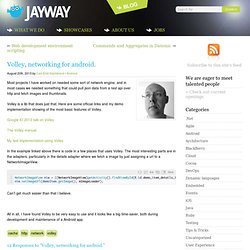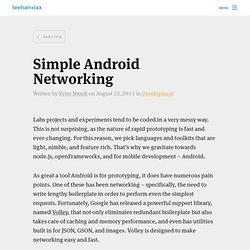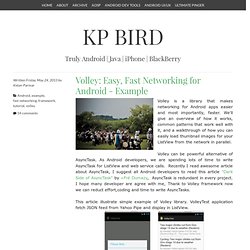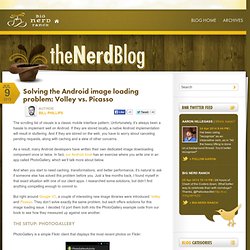

Android - Why does volley's response string use an encoding different from that in the response headers. Utf 8 - Android Volley API UTF-8. JsonObjectRequest. Class Overview A request for retrieving a JSONObject response body at a given URL, allowing for an optional JSONObject to be passed in as part of the request body.

Public Constructors public JsonObjectRequest (int method, String url, JSONObject jsonRequest, Listener<JSONObject> listener, Response.ErrorListener errorListener) Parameters public JsonObjectRequest (String url, JSONObject jsonRequest, Listener<JSONObject> listener, Response.ErrorListener errorListener) Constructor which defaults to GET if jsonRequest is null, POST otherwise. Protected Methods protected Response<JSONObject> parseNetworkResponse (NetworkResponse response) Subclasses must implement this to parse the raw network response and return an appropriate response type.
Returns The parsed response, or null in the case of an error. Can I do a synchronous request with volley. Google I/O 2013: Volley Image Cache Tutorial. Google I/O 2013 has come to an end, and it has left us with great anticipation for the future of Android development.

One of the more exciting things on display at I/O this year was a library called Volley. Volley is a library that handles the processing and caching of network requests, which saves developers from writing the same boilerplate code in virtually every application. Writing boilerplate code is never fun and is increases the chances of a mistake by the developer. It is with this in mind that Google has created Volley. If you have not seen the Google I/O presentation on Volley, I encourage you to go watch it to get an understanding of the basics before continuing with this article. Android Volley Library Tutorial. At Google I/O, Google debuted the new, hip way to make network requests within an Android application by introducing the world to the Volley Networking Library.

Like most new, hip toys these days Volley is fast, easy to use, and has ton of features. However, in many ways Volley is like a muscle car that came without instructions. This is due largely to the lack of documentation. Without the confidence and reassurance that documentation provides developers, an unwillingness to implement Volley exists, yet most everyone remains excited about Volley's future. If you haven’t gotten a chance to check out the Volley Library or watch the Google I/O Volley Presentation (also shown at the bottom of this post), I encourage you to do so. Asynchronous HTTP requests in Android using Volley - Arnab Chakraborty. Volley is the new Swiss Army Knife of Android Developers, it provides some nice utilities which makes the networking for Android apps easier and faster.

The good thing about Volley is that it abstracts away the low level details of what HTTP client library is being used under the hood and helps you focus on writing nice and clean RESTful HTTP requests. Additionally all requests in Volley are executed asynchronously on a different thread without blocking your “main thread”. What are the features that Volley provides? Important features of the Volley library: A high level API to make asynchronous RESTful HTTP requestsAn elegant and robust Request queueAn extensible architecture which allows developers to implement custom request and response handling mechanismAbility to use external HTTP client libraryRobust request caching policyCustom views to load and cache images from Network (NetworkImageView, ImageLoader etc)
Ogrebgr/android_volley_examples. Carlemil/VolleyDemo. Tuankma/Volley-demo. Volley, networking for android. By Carl-Emil Kjellstrand - Android Most projects I have worked on needed some sort of network engine, and in most cases we needed something that could pull json data from a rest api over http and fetch images and thumbnails.

Volley is a lib that does just that. Here are some official links and my demo implementation showing of the most basic features of Volley. Simple Android Networking. Labs projects and experiments tend to be coded in a very messy way.

This is not surprising, as the nature of rapid prototyping is fast and ever-changing. For this reason, we pick languages and toolkits that are light, nimble, and feature rich. That’s why we gravitate towards node.js, openFrameworks, and for mobile development – Android. As great a tool Android is for prototyping, it does have numerous pain points. One of these has been networking – specifically, the need to write lengthy boilerplate in order to perform even the simplest requests. Networking - Android Volley - Quickstart. Android - Volley library example.
I am not sure whether you have heard “Volley” word yet but it’s the library on which one expert talk was delivered during Google I/O 2013 by Ficus Kirkpatrick.

Volley: Easy, Fast Networking for Android - Example. Volley is a library that makes networking for Android apps easier and most importantly, faster.

We'll give an overview of how it works, common patterns that work well with it, and a walkthrough of how you can easily load thumbnail images for your ListView from the network in parallel. Volley can be powerful alternative of AsyncTask. As Android developers, we are spending lots of time to write AsyncTask for ListView and web service calls. Recently I read awesome article about AsyncTask, I suggest all Android developers to read this article "Dark Side of AsyncTask" by +Fré Dumazy, AsyncTask is redundant in every project. I hope many developer are agree with me, Thank to Volley framework now we can reduct effort,coding and time to write AsyncTasks. This article illustrate simple example of Volley library. Solving the Android image loading problem: Volley vs. Picasso. Jul 92013 The scrolling list of visuals is a classic mobile interface pattern.

Unfortunately, it’s always been a hassle to implement well on Android. If they are stored locally, a native Android implementation will result in stuttering. And if they are stored on the web, you have to worry about canceling pending requests, along with caching and a slew of other concerns. As a result, many Android developers have written their own dedicated image downloading component once or twice. And when you start to need caching, transformations, and better performance, it’s natural to ask if someone else has solved this problem before you.
But right around Google I/O, a couple of interesting new image libraries were introduced: Volley and Picasso. The Setup: PhotoGallery PhotoGallery is a simple Flickr client that displays the most recent photos on Flickr: Scroll it down, and you’ll see more pictures. PhotoGalleryFragment has a component called ThumbnailDownloader. And that’s it. The Slickness: Picasso. My tutorials. Volley: Easy, Fast Networking for Android — Google I/O 2013.